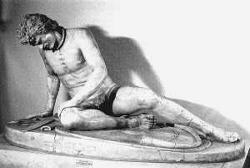April 20, 1833Emerson, age 30, continues his visit to Italy during his first travels in Europe. He will leave Rome in a few days and journey across the north to Venice.
I have paid a last visit to the Capitoline Museum & Gallery. One visit is not enough, no, nor two to learn the lesson. The dying Gladiator is a most expressive statue but it will always be indebted to the muse of Byron for fixing upon it forever his pathetic thought. Indeed Italy is Byron's debtor, and I think no one knows how fine a poet he is who has not seen the subjects of his verse, & so learned to appreciate the justness of his thoughts & at the same time their great superiority to other men's.
I know well the great defects of Childe Harold.
In the Gallery I coveted nothing so much as Michel Angelo's Portrait by himself.
Here is a link to the Capitoline Museum home page. The "dying Gladiator" which Emerson admires is usually called the Dying Gaul (in Italian, Galata Morente). Here are Byron's famous stanzas on the statue:
CXL.
I see before me the Gladiator lie:
He leans upon his hand--his manly brow
Consents to death, but conquers agony,
And his drooped head sinks gradually low -
And through his side the last drops, ebbing slow
From the red gash, fall heavy, one by one,
Like the first of a thunder-shower; and now
The arena swims around him: he is gone,
Ere ceased the inhuman shout which hailed the wretch who won.
CXLI.
He heard it, but he heeded not--his eyes
Were with his heart, and that was far away;
He recked not of the life he lost nor prize,
But where his rude hut by the Danube lay,
THERE were his young barbarians all at play,
THERE was their Dacian mother--he, their sire,
Butchered to make a Roman holiday -
All this rushed with his blood--Shall he expire,
And unavenged?--Arise! ye Goths, and glut your ire!{source}
In small, full-figure reproduction it's hard to see why the work called forth Bryon's eloquence:

But shows some of its expressive power in detail. Note the contrast between the Gaul and the other statues visible in this image:


Here is a link to the Wikipedia article on the statue: Dying Gaul.
Regarding Childe Harold, Emerson reflects Byron himself in alluding to defects since Byron publically declared the work to be pretty bad. Nonetheless, it made a huge impression and was one of the most widely-read poems of its day. Published over a period of years toward the end of the Napoleonic era, it is, says the Wikipedia author, "an expression of the melancholy and disillusionment felt by a generation weary of the wars of the post-Revolutionary and Napoleonic eras."
Here is a link to the Full text in Project Gutenberg.
These stanzas from the poem echo the view of Emerson and many contemporaries of the proud heritage and sorry present of Italy during the first half of the 19th century:
XLII.
Italia! O Italia! thou who hast
The fatal gift of beauty, which became
A funeral dower of present woes and past,
On thy sweet brow is sorrow ploughed by shame,
And annals graved in characters of flame.
Oh God! that thou wert in thy nakedness
Less lovely or more powerful, and couldst claim
Thy right, and awe the robbers back, who press
To shed thy blood, and drink the tears of thy distress;
XLVII.
Yet, Italy! through every other land
Thy wrongs should ring, and shall, from side to side;
Mother of Arts! as once of Arms; thy hand
Was then our Guardian, and is still our guide;
Parent of our religion! whom the wide
Nations have knelt to for the keys of heaven!
Europe, repentant of her parricide,
Shall yet redeem thee, and, all backward driven,
Roll the barbarian tide, and sue to be forgiven.
L.
We gaze and turn away, and know not where,
Dazzled and drunk with beauty, till the heart
Reels with its fulness; there--for ever there -
Chained to the chariot of triumphal Art,
We stand as captives, and would not depart.
Away!--there need no words, nor terms precise,
The paltry jargon of the marble mart,
Where Pedantry gulls Folly--we have eyes:
Blood, pulse, and breast, confirm the Dardan Shepherd's prize.
Here is an image of the Michaelangelo self-portrait to which Emerson refers:





No comments:
Post a Comment